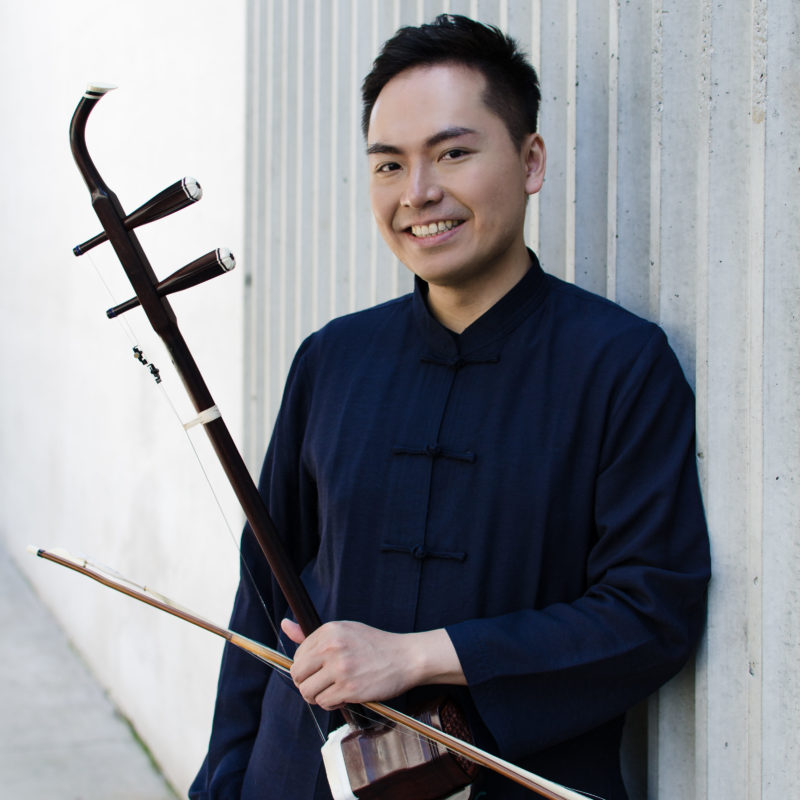River Oaks CO achieves liftoff with premiere of celestial erhu concerto

When the River Oaks Chamber Orchestra commissioned Kevin Lau to write a concerto for erhu, the two-stringed Chinese instrument, he sidestepped the obvious approach. Rather than seek inspiration in the music or culture of the erhu’s homeland, the Chinese-Canadian composer turned to a favorite subject of his own: space exploration.
Between the Earth and Forever was presented by ROCO in its world premiere Saturday night in Houston’s Church of St. John the Divine. The work takes its name from the caption Lau spotted beneath a photograph of an astronaut on a spacewalk. That combination of image and philosophy fired his imagination.
Lau’s concerto casts the solo instrument in a role like that of the photo’s astronaut: The erhu, with its slender, pungent tone, takes off on a journey through the sonically alien realm of the sonorous Western orchestra.
As the composer’s program note declares, his score leans into the best-known association there is between the orchestra and space exploration. Echoing the start of Richard Strauss’sAlso Sprach Zarathustra—iconic due to its usage in 2001: A Space Odyssey—the concerto begins with a long, hushed low note in the basses–here doubled high in the violins–and a spacious French horn theme whose first phrase spans an octave. (In a second Hollywood echo, perhaps unintentional, the horn’s first four notes are the same as those of the once-famous theme from Exodus.) The orchestra–led Saturday by guest conductor Christopher Rountree–builds the horn’s theme into a spacious, lush introduction that creates a majestic sonic panorama.
The erhu, played by soloist Andy Lin, enters with the first of a series of ardent solos. Each strand of erhu tone seems otherworldly, partly due to its contrast with the orchestra, yet also due to its human tinge and Lin’s generous vibrato.
The erhu’s soliloquies ring out ardently, thanks to their wide-ranging melodies and bursts of melisma. A lighter, more dancing air makes a fleeting appearance.
As the single-movement, 15-minute concerto unfolds, the orchestra adds its own hints of the extraterrestrial with strings sliding between pitches. Surges of orchestral agitation bring a more turbulent episode, and the erhu–boosted by amplification–gets caught up in the clangor. But the return of the horn’s theme helps return the music to its moorings, and the concerto ends on yet another otherworldly note–dying out with a quiet, long-held chord that the orchestral musicians hum.
In the hands of soloist Lin, the erhu proved a compelling musical protagonist Saturday. Lin spun out the solo line with nimbleness, lyrical poise and dramatic flair; sometimes he ratcheted up the urgency through a more intense vibrato.
Led by Rountree, the orchestra brought Lau’s score a richness and glow that suggested a larger group than three dozen players.
The tall, burly conductor directed the group with broad gestures that helped propel the concerto’s outbursts. But he also brought the music breadth and delicacy when needed.
Even when Saturday’s concert wasn’t evoking outer space, it covered a lot of territory.
Rountree and the orchestra began with Darker America, a William Grant Still tone poem from 1924 depicting African-American life. Built on themes reminiscent of spirituals, Darker America is sometimes soulful, sometimes plaintive, sometimes hopeful. When optimism wells up, the score hints at the jazz-tinged orchestral style most associated with George Gershwin.
But a meditative tone prevails, and the orchestra captured that most powerfully when the strings, guided by Rountree, sang out Still’s melodies with red-blooded fervor. The winds’ crispness and energy added another type of ardor, and Rountree shaped the score’s muted, questioning close deftly.
The orchestra followed Lau’s premiere with three vignettes from a yearlong ROCO commissioning program for fanfares and interludes.
Alejandro Basulto’s Fanfarria de Feria contrasts two kinds of fanfares–an imposing, classical-type one and a bouncier one rooted in Mexican pops culture–and the orchestra brought out the former’s heft and the latter’s bounce.
In Kathryn Salfelder’s Epherema, a halo of strings surrounds a French horn’s broad, quiet phrases, and a piano adds gentle punctuation. Rountree and company brought the score transparency and calm.
Birds competing around a feeder are the title characters of Jess Langston Turner’s Fanfare and Riffs for Tiny Despots, which sets off a riot of orchestral squawks and twitters and the players cut loose with abandon.
After that tumult, the subdued opening of Mozart’s Masonic Funeral Music at first seemed out-of-place. But the winds intoned the Gregorian melody so spaciously–and the violins adorned it so deftly–that the work’s somberness took hold. And at the climax, the winds opened up with a full-throated, keening intensity.
The concert closed in yet another musical era–with excerpts from Jean-Féry Rebel’s baroque extravaganza Les élémens.
Rountree and the orchestra hammered out the opening dissonance of “Chaos,” the work’s main claim to fame, with gusto. They played up the movement’s contrasts between dynamism and mystery, then savored the bravura of the Chaconne–with the violins and violas tossing off their flourishes breezily.
The glittering flutes of “Nightingales” harkened back to the avian antics of Turner’s Tiny Despots. And Rountree spurred the orchestra to fill the “Caprice” with lustiness and brilliance.
Members of the River Oaks Chamber Orchestra play chamber music featuring the French horn 5 p.m. Feb. 22 at the Midtown Arts and Theater Center Houston. roco.org; 713-665-2700.


